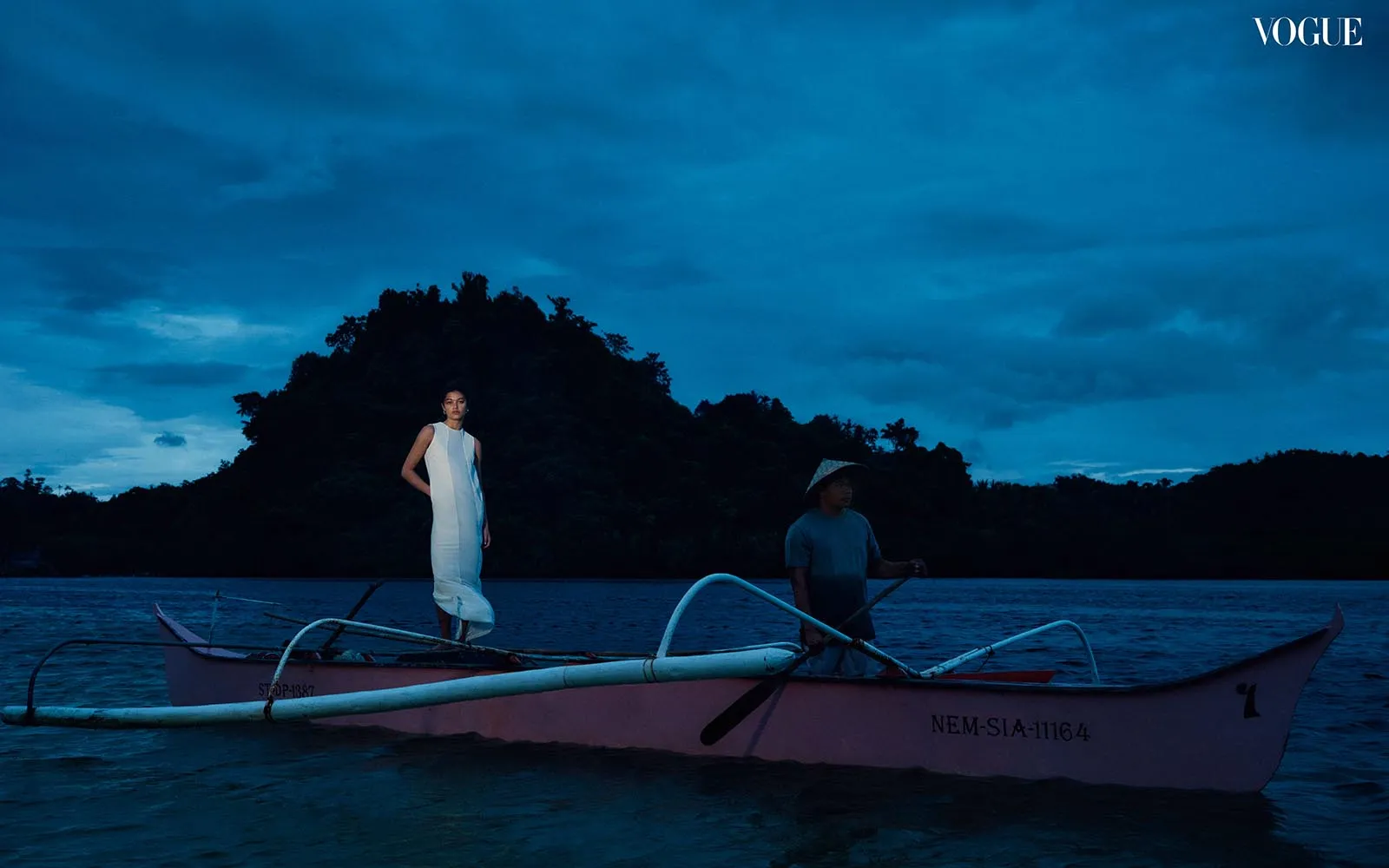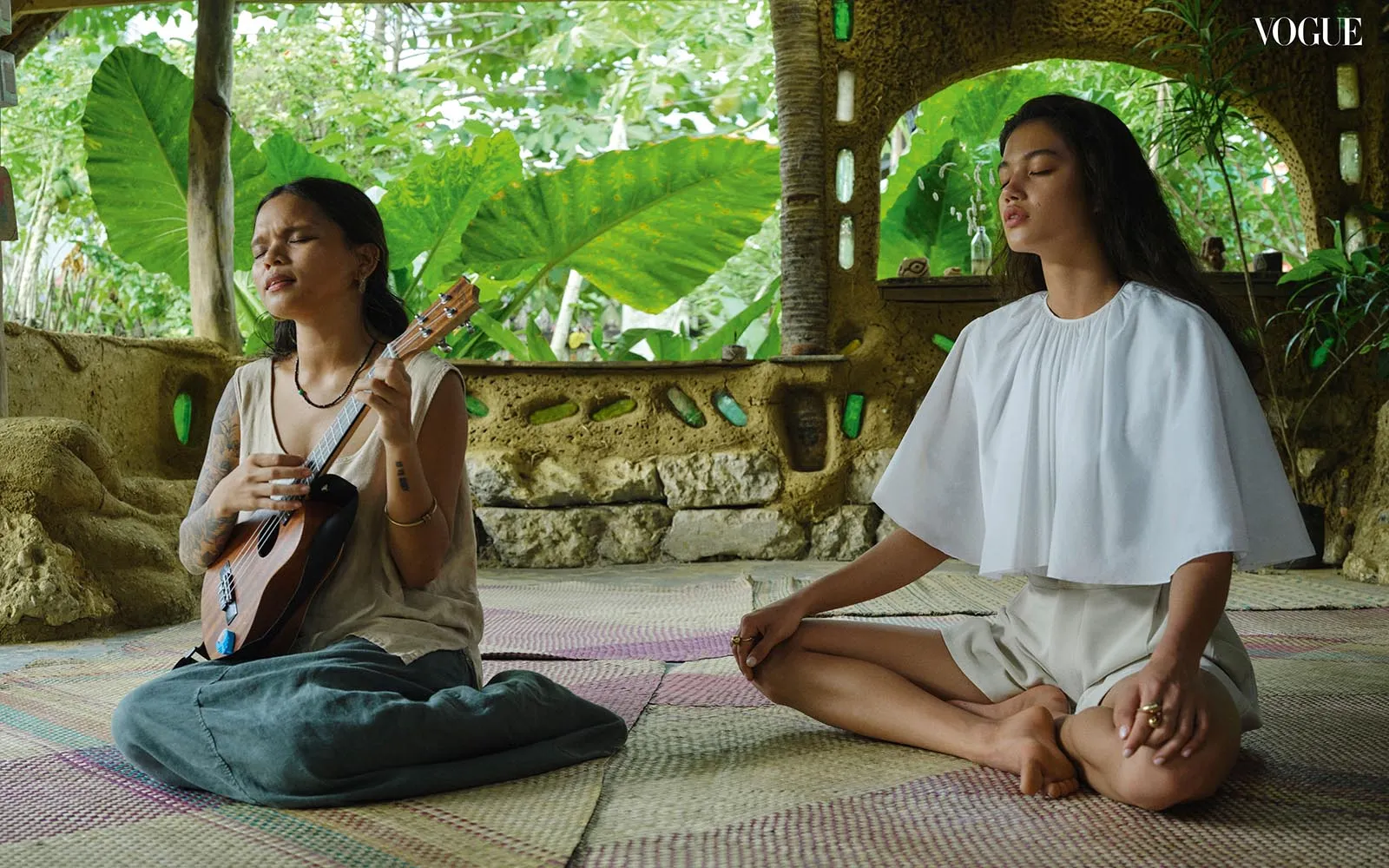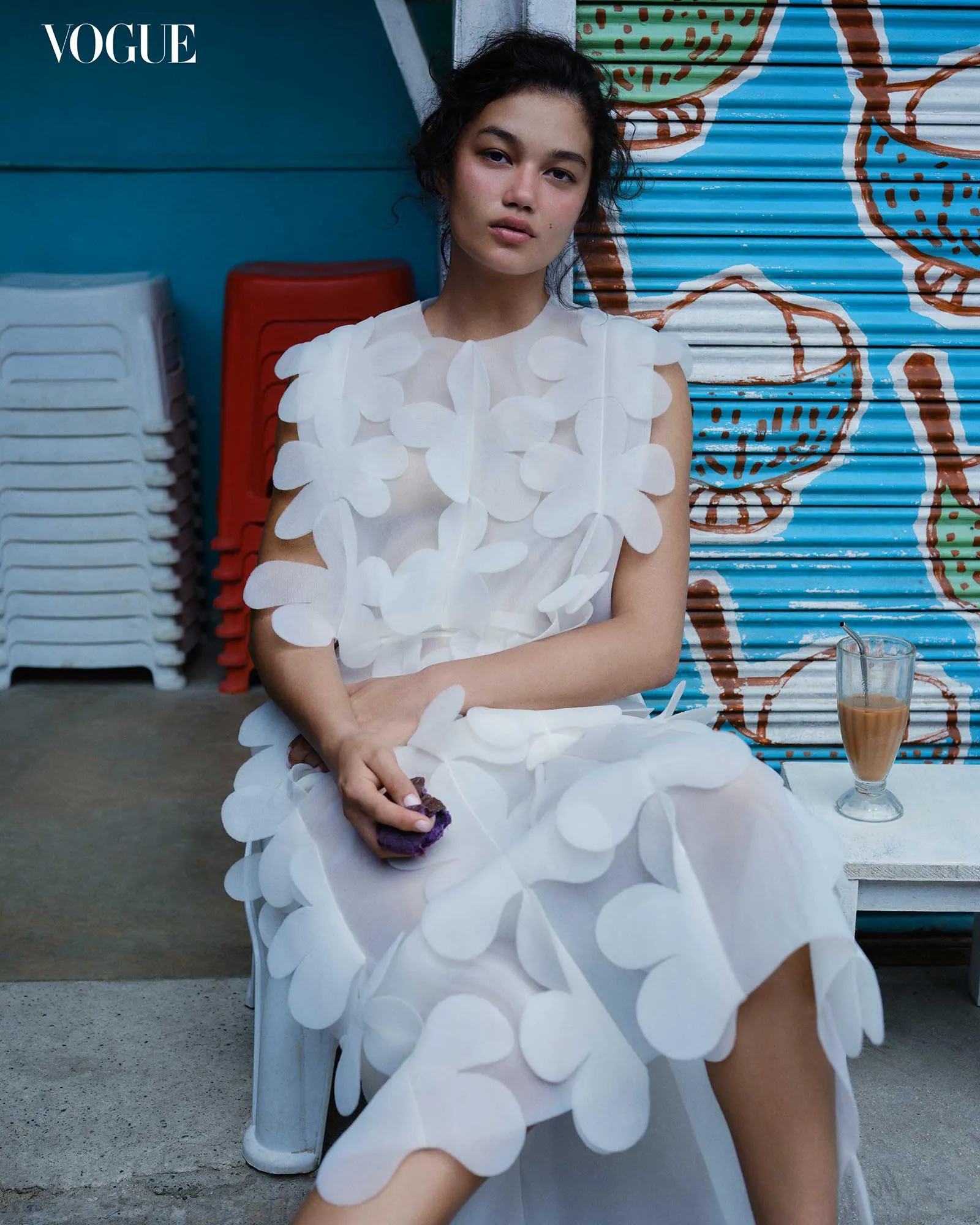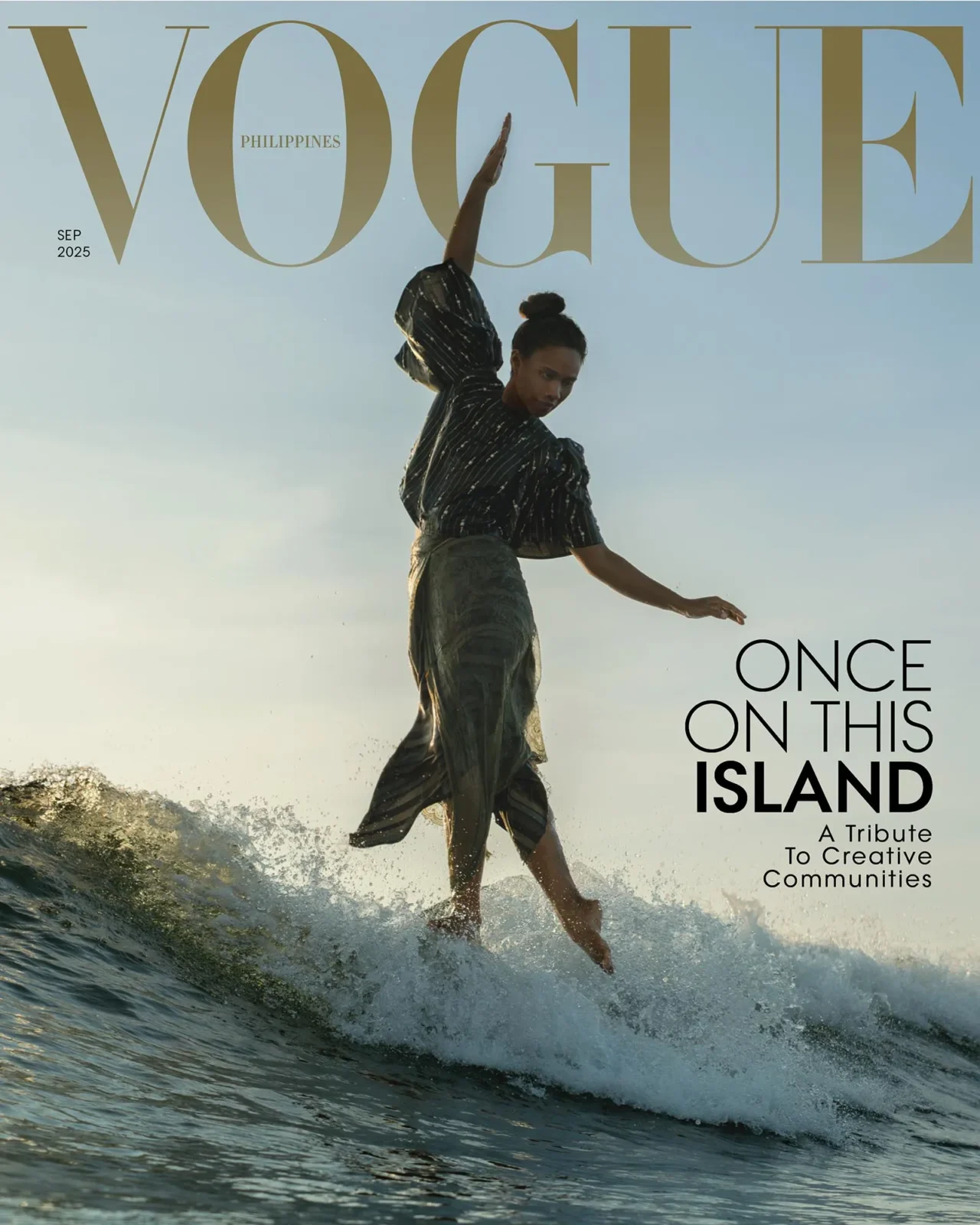FALLEN ANGELS
Along for the ride on one of Siargao’s sprawling bridges, Natasha wears a FAH CHAK dress, ELEMENTAL BY SELA rings, and DIOR satin sneakers. Photographed by Sharif Hamza for the September 2025 Issue of Vogue Philippines
BREEZING THROUGH
Natasha wears a GIA STUDIOS top and trousers and SOFIA ABOITIZ HERRERA necklace. Shot on location at Inara Siargao. Photographed by Sharif Hamza for the September 2025 Issue of Vogue Philippines
On the island of Siargao, light, story, and spirit converge in moments of reflection and discovery.
Every day before sunrise, Roel “Ew Ew” Escoltura heads out to sea. Two decades ago, he would have been out on an outrigger boat, catching fish to feed his family to sell at the market. These days he’s out in the surf, pushing a board for a visitor trying to catch their first wave. The times have changed, but the tides haven’t. They bring in the fish, though perhaps not as abundantly, and they bring in the waves, a constant dance between push and pull. Kuya Ew Ew comes from a line of fishermen and has always known that the sea is the source of life and livelihood. He loves spearfishing most of all, and is widely known as one of the island’s best freedivers, having swum in Siargao’s waters almost as soon as he started walking. He used to be afraid of the sharks, but after countless dives with them, he says with a grin, “I just play with them now.” Over the years he has taught many others how to freedive the way he learned, through instinct and patience, surrendering completely as breath and body dissolve into the ocean. Lately, he has stopped teaching because new regulations on the island require instructors to undergo formal training to be licensed.
Jolan Saavedra, his nephew and a community organizer, didn’t take to fishing as easily. “If you don’t like this kind of life, then you should study,” his father told him sternly. Jolan left for Manila, as many Siargaonons do to finish college and find work beyond subsistence fishing and farming. City life did not suit Jolan, however. “We islanders get sick if we can’t touch the sea,” he says. Even if life was hard growing up (Jolan recalls only being able to buy slippers every few months, if copra was sold), Siargao remained in his memory as a kind of heaven, an unpaved paradise where, at night, thousands of fireflies lit up the mangrove trees. He returned years later to an island that had changed, but one he hoped to help shape in return.
In the 1970s and ’80s, only a handful of adventurous surfers made their way to the island, driven only by the singular desire to find the next perfect wave. It remained a secret spot, an idyllic Eden of coconut groves and thatched-roof homestays. Knowledge of the place was passed through word of mouth within the tight-knit, itinerant community of surfers. Then in 1992, a trio of American surfers set out to explore the east coast of the Philippines, hoping that the Pacific typhoon swells would deliver some epic waves. After flying from Manila to Cebu then to Surigao, they took a six-hour boat ride to Siargao, landing right at the glorious height of habagat season. In the municipality of General Luna they found just the wave they were looking for. One of the surfers, John Callahan, named it “Cloud 9” after the local candy bar.

Siargao gradually blew up in the surf world after Callahan’s photos were published in international magazines. But surfing was still a niche pursuit, and the number of visitors to the island remained low, with less than 14,000 international arrivals in 2012. Some of them never left. Foreigners continued to put down roots in Siargao, opening restaurants and small resorts, building homes and integrating with the villagers. Another narrative shift occurred starting in 2015 with the opening of Harana, the first resort founded by Filipinos from Manila. The following year saw the start of direct flights from Manila, but it was the 2017 film Siargao that catalyzed mass travel from non-surfers and would-be surfers alike.
What The Beach did for Ko Phi Phi and Eat Pray Love did for Bali on a global scale, That Thing Called Tadhana did for Sagada locally. Siargao, with its tropes of escapism and self-discovery in an exoticized locale, is in good company. By Holy Week 2018, images showed travelers crammed on Catangnan Bridge at sunset (also known as AFAM bridge for bringing together locals and foreigners looking for romance); while the famous wooden boardwalk heaved under the weight of all its spectators. Cloud 9 was nicknamed Crowd 9. Another factor chummed the waters further: the six-month government-mandated closure of the “cesspool” Boracay island in April 2018. The Department of Tourism’s redirection campaign forwarded many travelers to Siargao, a destination that was wholly unprepared for the influx.
When Vogue Philippines visited Siargao in June and July, we arrived with as few expectations as possible. I had yet to watch the movie Siargao, which would have tried to skew my perception of the island as a getaway, a place to shed your inhibitions for a few blissful days before returning to real life. Instead, we came hoping to understand what it’s like, to feel the reality of what it is like to live here, as a native or as a transplant, someone with deep roots, or tending new ones.

“This is not about the location as a scene,” photographer Sharif Hamza said early in the trip, “but approaching the story as a narrative, and not just a girl in a series of locations.” Still, the first couple of days felt disorienting. Sharif was taken aback by the volume of tourists and how difficult it seemed to navigate the terrain. “This is low season,” locals told him. “During high season, you’d be surfing in a sea of tourists.”
I’m aware of the inadequacy of staying in Siargao for a mere five days and expecting to discover its essence (as the film did, with the pithy takeaway “you will not fall in love in Siargao, you will fall in love with Siargao”), so we sought to meet the people where they were, and listen to their stories. What we heard were overlapping waves of love and concern, from fishermen like Kuya Ew Ew, who sees surf tourism as a path to a better life built at home. We spoke to longtime residents critical of how some foreigners run businesses on the island, exploiting local labor or not hiring them at all. And we heard from local officials working on more equitable, sustainable development. As Jolan points out, “Locals can only afford to put up small businesses. But we share all the island’s resources, water, food, electricity.”
In those few days, we let go of our predetermined schedules and page plans and opened ourselves up to the island, letting its rhythms unfold, following its lead. The people, the pace, and all the in-between moments (like the after-meal glow on model Natasha Neilson as she casually sits in the kinilaw restaurant Cev) revealed themselves in the process.

A simple white cross stands on a cliff on Tuason Point, overlooking the barreling waves of Cloud 9. Local lore traces its origins to Doris Camingue, a respected pillar of the Catholic community who dreamed of putting up the cross as a shrine and space for contemplation and prayer, inspired by the Glorious Cross of Dozulé in Normandy, France. Atty. Camingue was a trailblazer, in 1965 becoming the first female lawyer from Siargao as well as its first female mayor when President Corazon Aquino appointed her OIC Mayor of General Luna in 1986. The cross was finally raised on her family’s property in 2005, and has since been credited with protecting the island from severe storms and calamities, a sense of assurance that endured, at least until the next decade and a half.
A particularly calamitous storm came through on December 16, 2021, the strongest typhoon Siargao had experienced since Super Typhoon Nitang in 1984, which anyone over 40 would remember for the catastrophic flooding and destruction it caused, though there were far fewer houses back then. This time, the residents were more prepared, tracking the swirling mass on satellite images as it crept closer to the Philippine Area of Responsibility. But nothing could have prepared them for the storm’s force. In the last few hours before landfall, Odette had quickly intensified to a Category 5 typhoon.
“I know I’m doing the right thing because it’s what our ancestors, our grandfathers and grandmothers, would want: to fight for what we have.”
Maria Tokong
Hundreds of stories are told about the apocalyptic aftermath and recovery arc of Siargao’s survivors, and thousands more remain untold. Yet the island rebounded faster than anticipated, with recovery taking months instead of years, thanks in large part to the outpouring of support from individual and corporate donors. Many resident business owners also played a crucial role, channeling their resources into relief efforts and communal rebuilding. By the end of 2023, Siargao received a tidal wave of visitors numbering nearly half a million (90 percent of them domestic), exceeding even its pre-pandemic levels.
While the numbers sound overwhelming for a fifth-class municipality like General Luna, visitors can always hie away from the well-trod path that is Tourism Road, aptly named. A motorbike trip about two hours to northern Siargao will reveal places that still feel raw and undeveloped, with empty beaches whose mellow waves are ideal for beginner surfers. The pace is much slower and the vibe chiller, yet you can still find creature comforts like avocado toast and a proper flat white in little cafes along the coast, a sign that one is never really that far off the (Instagram) grid.
Venture beyond the beach and you’ll find another subset of board culture: the skater. They carve down Malinao Road, cruise across the Catangnan bridge, or drop in on the Bravo Skate Bowl, which is Clintoy Mangco’s favorite spot to flow. Clintoy, a surf instructor and tour guide known for giving guests a more rooted experience of Siargao, picked up surfskating during the pandemic when he was unable to surf. The sport first became popular in the ’90s as a way for surfers to keep practicing on land during flat days, using skateboards with pivoting front trucks that allowed for a more fluid ride. Clintoy, who learned how to both skate and surf on borrowed boards when he was a kid, quickly took to the hybrid art, which is less about tricks than it is about grace and style. With a few other local skaters, he represented the Philippines for the first time in an international competition last year, taking home the silver medal. “Ang goal namin na makaron ng connection sa mga kapwa surfskaters dito sa Asia,” Clintoy says, “at makilala rin na may talent ang mga taga-isla, taga-probinsya.”

At Tending Gardens, an earthmade community space in General Luna that draws crafters, herbalists, artists, and dreamers, Maria Tokong welcomes the Vogue Philippines crew with a gently strummed tune on her ukulele. Longing and loving, the song “Hanan” is an ode to the Siargao she remembers and dreams of returning to. Maria speaks candidly about the moment she realized she had to use her voice, even at the risk of sounding kooky. She had been preparing for a full moon ritual that coincided with the local elections. After casting her vote, she went straight to the beach to gather with friends, her partner, and a baylan. As they chanted and sang and communed with nature, she felt a spirit touch her with a message that said not to fear, your voice is your power. Soon after, Maria shared her thoughts on social media, expressing the widely-felt unease around the cultural conflicts transpiring on the island. The post went viral and was picked up by news outlets, linking her words to broader resistance movements against settler colonialism.
“I’ve been singing all my life, been holding different mics, standing on different stages. It’s really part of me to have a voice,” Maria says. “I know I’m doing the right thing because it’s what our ancestors, our grandfathers and grandmothers, would want: to fight for what we have.”
After the last image was shot and the Vogue team left the island, Sharif surprised us by staying on for almost two weeks with his family, and yes, he did fall in love with Siargao. He was moved by the genuine warmth of the local instructors and guides, and inspired by the Filipino youth turning surf and skate culture into something uniquely their own. He loved watching surfers like Ikit and Aping Agudo soak up the sun with their deep brown skin, a powerful image that he sees reflected in his own daughters. Having grown up far from his roots, the island felt akin to coming home.
To visit Siargao is to witness a community actively writing their future. To leave is to carry a memory that cannot be captured, only felt and moved with, like the energy of waves constantly shaped by the changing winds. The conversations we had and connections we made linger on, imprinted in the shape of an island where islanders still dream.
See more of this story in the Anniversary Issue of Vogue Philippines, available at the link below.
By AUDREY CARPIO. Photographs by SHARIF HAMZA. Deputy Editor PAM QUIÑONES. Fashion Editor DAVID MILAN. Art Director: Jann Pascua. Media Channels Editor: Anz Hizon. Producer: Bianca Zaragoza. Cinematographer: MV Isip. Makeup: Pam Robes. Hair: Mong Amado. Model: Natasha Neilson of The Industry Model Management NYC. Associate Fashion Features Editor: Ticia Almazan. Fashion Associate: Neil de Guzman. Multimedia Artist: Mcaine Carlos. Nails: Extradordinail. Photography Assistants: Choi Narciso, Sela Gonzales, and Odan Juan. Local Production Team: Andrea Luis, Camille Robiou du Pont, Lerizze Dizon-Casel of TADA Studios. Local Suppliers: Amon Cafe, Bayani Restaurant, and Coastal Reef Adventures. Video Assistant: Rain Ornada. Additional interviews by Ticia Almazan.
Special thanks to Cebu Pacific, Sunlight Air, Admiral Hotel Manila, Harana Surf Resort, Bayud Boutique Resort, and Domu Mia Villa.
- The Pearls Project Connects Women Who Surf Along Different Shores
- After Years of Capturing the World Outside Her, Hannah Reyes Morales Turns Her Gaze Inward
- Four Pioneers of Philippine Fashion Image-Making Look Back on an Era They Helped Define
- The Members of Aktor PH Take On Their Most Meaningful Role Yet

